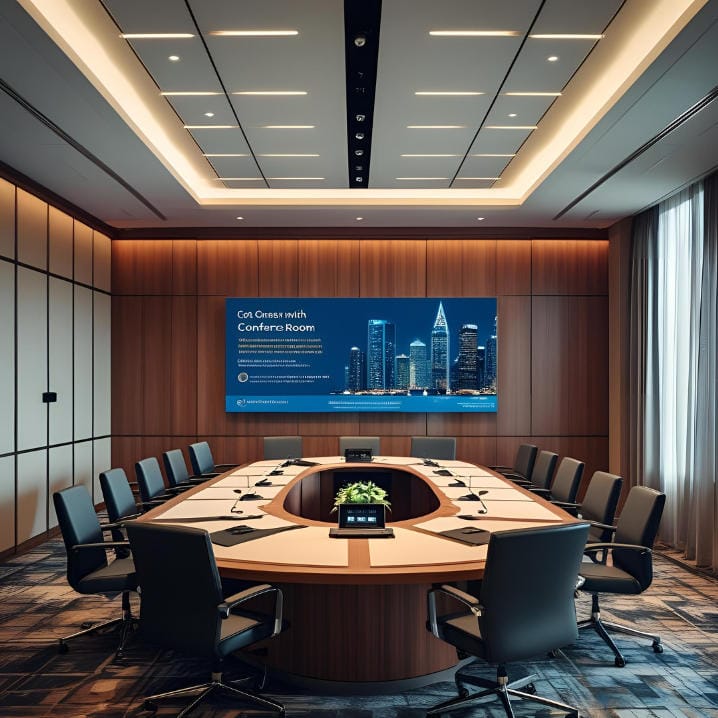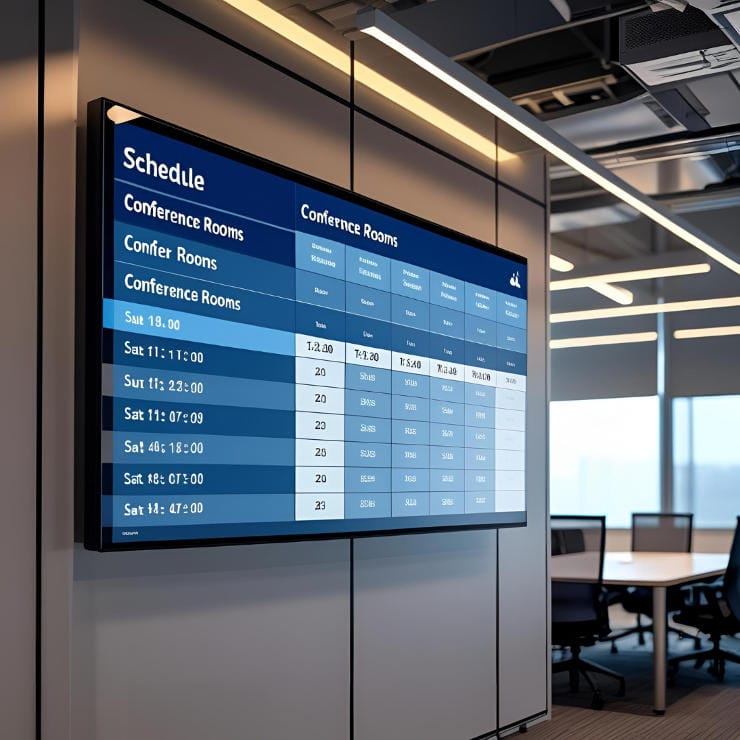In the corporate world, most people view conference rooms as quiet, serious spaces for long and possibly boring meetings. Yet, thanks to digital signage in conference rooms, businesses are making these areas more vibrant and interesting. No matter if you’re running brainstorming, strategy sessions or team review meetings, using digital signs will liven up your conference rooms, help with communication and support teamwork. This blog will examine how digital signage in conference rooms can help make meetings more enjoyable, useful and memorable for everyone attending.
 What Is Digital Signage for Conference Rooms?
What Is Digital Signage for Conference Rooms?
Revolutionizing Conference Room Environments
Conference rooms use digital signage to display information, manage meetings and encourage teamwork. They aren’t limited to plain signs and menus. Video conferencing can be done with conference room monitors, digital signage displays can share meeting information and interactive screens help teams brainstorm and collaborate at the same time. By using these systems, meetings are livelier, organized and keep everyone interested and involved.
Benefits of Digital Signage in Large Conference Rooms
Clear Visibility and Multi-Screen Functionality
It can be hard for people seated far back in a big conference room to see the screen. Thanks to digital signage, everyone can easily read presentations and schedules or watch video conference feeds because the displays are large and high definition. If you have many conference room screens, you can show slides, a live chat, and input from remote team members, which allows you to do several things at once and increases your productivity during meetings.
Central Planning and How the City Looks
If you use a digital signage solution, you can easily manage and change content, schedules and images from a distance. You can be sure your presentations will be smooth and on time with this feature. Also, clean digital screens make the room look stylish, reflecting your company’s innovative and modern image. They are both useful and help make the space look more elegant.
Creative Ways to Use Conference Room TV Displays
Personalizing the Meeting Experience
Besides showing presentations and video meetings, conference room TVs have many other uses. You might try using these screens to welcome people and encourage them with motivational messages at the start of the meeting. You can get everyone’s attention by showing a short trivia question or a fact about your team as they come into the room. They allow people to connect and enjoy the meeting right from the start.
Interaction in Real-Time and Mood Settings
During conferences, you may present live polls and surveys to collect feedback instantly from people present. It’s a great way to make sure everyone participates and talks with each other. In addition, you could make mood boards or visual themes with the screens to match the reasons for the meeting. For example, while brainstorming ideas, you can show engaging visuals to inspire the team. While you are not running sessions, show employees peaceful songs or entertaining videos to support their moods.
Interactive Conference Room Signs That Engage
Transforming Static Signs into Interactive Tools
It’s no longer enough for conference room signs to only indicate whether a room is free or occupied. Having an interactive sign in your conference room lets people book their meetings with ease, greet them with their names and display how much time there is left until the next event. The way I behave depends on the purpose of the meeting, whether it’s for creative ideas or a top-level discussion. With interactive signs, your meeting areas can be adapted easily to meet your team’s needs, becoming more interesting and dynamic.
 Boosting Collaboration with a Conference Room Monitor
Boosting Collaboration with a Conference Room Monitor
Real-Time Collaboration at Its Best
The heart of any meeting involving collaboration is the conference room monitor. When linked to group software, these monitors help teams collaborate on ideas, add comments to documents and talk with each other as they work. Thanks to live annotation, people participating in a meeting can draw or write directly on the screen to share their thoughts. Additionally, using digital whiteboards and multi-source input allows several devices to link up, so sharing data, screens, or applications is simple. It helps people connect better and collaborate more smoothly.
Hybrid Integration for Remote Teams
Given that remote work is now common, it’s a good idea to have video conferencing software on your conference room monitors. As a result, people on both teams are included in the meeting, making sure no one gets left out due to their location. When you use hybrid integration, your meetings become more welcoming and let people interact more effectively.
Using Conference Signage to Promote Company Culture
Aligning Conference Room Displays with Your Company’s Identity
Conference signage is practical, but it can also help spread your company’s culture. Mark important dates for your team, such as birthdays and milestones, with signage in the conference room. It encourages teamwork and helps your workplace feel more enjoyable. Showing company values, diversity and inclusion messages and listing upcoming events can help all employees stay on track with the company’s mission and vision. When you highlight your culture, it becomes part of your team’s regular activities, which helps everyone feel closer.
Gamification and Team Bonding with Digital Displays
Making Meetings Fun with Interactive Challenges
Using gamification in meetings will help your team stay interested. To make team scoreboards, use digital displays or hold interactive games during stoppages to keep everyone engaged. You can put up team goals such as “Try to avoid saying ‘um’ more than three times” or “Make sure this meeting lasts less than 30 minutes.” Then, follow their progress live during the meeting. A leaderboard on the screen allows you to celebrate the top players and encourages everyone to compete in a healthy way.
Showcasing Achievements and Celebrations
Highlighting Success and Building Team Pride
Digital signage is a useful way to celebrate success. You can display recent achievements in your conference room, including finishes to projects, sales goals or what customers have said about your company. Support team promotions, welcome new hires and spotlight employees in your messages, so everyone feels valued. When you highlight these achievements on digital displays, you help build an atmosphere that inspires employees to perform well.
Tips for Choosing the Right Digital Signage for Conference Rooms
Choosing the Perfect Setup for Your Needs
Before choosing digital signage for your conference rooms, look at a few important things.
- Room Size: If the room is large, you should use bigger or more screens to help everyone watch comfortably.
- Use Cases: Choose equipment that will allow you to show real-time dashboards, hold video calls or present information if that’s what you will need.
- Interactivity: Touchscreens and interactive signs in conference rooms offer extra flexibility and an opportunity for everyone to take part.
- Compatibility: Make sure the system can be used with calendars (Google Workspace, Outlook), video conferencing services (Zoom, Teams) and collaborative applications.
- Central Management: Go for content management systems that give you control over everything from a single place and make updates easy.
Best Practices for Maintaining Fun and Productivity
Keeping Your Conference Room Environment Balanced
A good mix of fun and work is important for children. Changing the content often helps prevent boredom and keeps your team interested. Invite your team to select the items you display, such as mood boards, quotes or playlists, to make your conference rooms more friendly and inviting. Don’t let the fun side of things distract from the key purpose of the meeting. Place signs around the room to reflect the mood you want for each type of meeting.
Revolutionize Your Conference Rooms Today!
You can bring excitement to your meetings by using digital signage in your conference rooms. No matter if you add interactive displays, highlight your company values or include games, digital signage allows people to communicate more effectively. You can start using it right now and see the benefits at your next meeting!
FAQs on Quick Service Restaurant Displays
What is digital signage for conference rooms?
Digital signage for conference rooms involves putting digital screens, TVs or monitors in conference rooms to show schedules, collaboration tools, presentations and team messages. It improves how meetings are conducted, organized and participated in.
How do conference room signs work?
In most cases, today’s conference room signs are digital and can be used interactively. Once linked to scheduling software like Google Calendar or Microsoft Outlook, they will automatically display who is available, the meeting name and the people attending. A few allow guests to book their room immediately using the touch screen.
What size TV is best for a large conference room?
Conference rooms that seat more than 20 people should use a display of 65 inches or more. When a room is very large, perhaps two monitors or a video wall are required so all viewers can see the presentation from anywhere.
Can I use a regular TV as a conference room monitor?
A regular smart TV can be used as a monitor in a conference room as long as it has HDMI, casting or other ways to connect. Yet, to achieve the best results, buying a commercial-grade display gives you brighter screens, extended use and warranty assistance.
What content should I display on conference signage?
You can add meeting agendas, welcome greetings, team news, updates on projects, motivational sayings, spotlights on employees and company announcements to your content. During breaks, you might want to play trivia, display mood-themed pictures or have themed music playlists.
Are interactive conference room signs worth it?
Yes. Interactive signs make it possible to make bookings right away, greet guests personally and update information promptly. They eliminate overlapping events and become easier for users to use.
How do I manage multiple conference room displays?
The majority of digital signage platforms have cloud-based management tools. Admins can instantly manage displays, update information, organize content and keep an eye on the system’s health using a single dashboard.
Can digital signage really make meetings more fun?
Absolutely. Using creative, interactive, personalized and even funny elements, digital signage helps reduce boredom, increase happiness and promotes teamwork—all important for making meetings both fun and effective.


 What Is Digital Signage for Conference Rooms?
What Is Digital Signage for Conference Rooms? Boosting Collaboration with a Conference Room Monitor
Boosting Collaboration with a Conference Room Monitor


